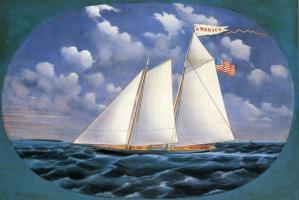 Shortly after winning the Sydney Hobart Race for the third time, the maxi-yacht Comanche has been sold by its current owners, Jim Cooney and his wife Samantha Grant, to Russian interests. Perhaps, oddly enough, the transaction brought to mind the yacht America of 1851.
Shortly after winning the Sydney Hobart Race for the third time, the maxi-yacht Comanche has been sold by its current owners, Jim Cooney and his wife Samantha Grant, to Russian interests. Perhaps, oddly enough, the transaction brought to mind the yacht America of 1851.
International yacht racing has traditionally been a sport for the rich. The cliche that a yacht is a hole in the water into which the owner pours money, is often repeated because it is, more often than not, highly accurate.
In rare cases, however, there are exceptions. One such example was the syndicated formed by John Cox Stevens, the founder and first commodore of the New York Yacht Club. The idea was to build a racing yacht to show off U.S. shipbuilding skill and to make money through competing in yachting regattas.
The design of the schooner America was based on George Steers’ pilot boat designs, whose concave waterlines were influenced by the designs of American clipper ships. On August 22, 1851, America won the Royal Yacht Squadron’s 53-mile (85 km) regatta around the Isle of Wight by 18 minutes and was awarded the squadron’s “One Hundred Sovereign Cup.”
What does this have to do with the sale of Comanche ? Just as Comanche was sold shortly after her recent Sydney Hobart race, so too was the schooner yacht America sold within weeks of winning the One Hundred Sovereign Cup to John de Blaquiere, 2nd Baron de Blaquiere. I am not aware of any record of the transaction, but it was rumored that Stevens and his investors netted a tidy profit in the deal. Stevens and his team sailed home with the cup which would subsequently be known as the America’s Cup.
In the first America’s Cup challenge race of 1870, the famous schooner was one of the competitors. After passing through several owners, including a short career as a Confederate blockade runner during the Civil War, schooner America was owned by the US Navy in the first America’s Cup race. The schooner came in 6th overall.

Boat is a accronym.
Bring
On
Another
Thousand
I get so pissed off with “the rich man sport” bit. The sport employs tens of thousands of people worldwide in an industry which is nothing short of philanthropy.
This is a quote from my soon to be published book:
“Often associated with privilege and class, the reality could not be further from the truth. In it we participate in a dangerous sport in a confined space working with all creeds, colours, religions, ages, backgrounds and any other box that one might be put into and who you may or may not like. Regardless you must perform physically and mentally demanding choreographed manoeuvres, problem solve, work as a team and as an individual.
More importantly, of an evening, you must socialise with your crew of all creeds, colours, religions, ages, backgrounds and who you may or may not like. As a sport, sailing creates young people with sound team working, man management and social skills of the highest level.”
It is the guys low down that the generosity of the guys at the top makes possible creates some of the best sport in the world.
The Comanche cost a reported $15 million to build. That doesn’t include outfitting, upkeep or crew costs. I have no doubt that the other four maxis in race cost more. To my mind, that is a rich man’s sport. This doesn’t mean that anyone with a boat is rich or that the thousands of those employed in the industry are rich either. This is also the case in all other “rich men’s sports” from horse racing to grand prix racing.
You can have a boat or you can have money. You cannot have both.P
I only wish sailboat racers knew to follow rules of the road. Or at least, not traipse back and forth across harbor entrances (pet peeve of Squalicum Harbor).
As to the rest, if some fraction of things that racers commission to design and build trickle down to reproducible technology the rest of us can employ, terrific. Fin keel with a hefty bulb? Antiquated in the elite racing world but at my level, I like. Buying one attached to a boat at an affordable price? Even better. And somebody else paid to cut all of that brush. 🙂